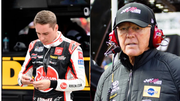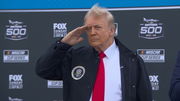
via Imago
Credits: Imago

via Imago
Credits: Imago
Ryan Preece’s harrowing accident at Daytona cast a veil of uncertainty over NASCAR, eliciting a cascade of unanswered questions. However, as time passed, a growing chorus of voices, including drivers and NASCAR insiders, joined the discourse, shedding light on the pertinent issues.
Previously, luminaries such as Denny Hamlin, Kyle Busch, and the Door Bumper Clear crew convened to deliberate upon the circumstances surrounding Preece’s perilous encounter at the Daytona circuit. Now, even Kevin Harvick has lent his perspective to this ongoing dialogue, offering insights and recommendations aimed at averting such catastrophic incidents in the future.
ADVERTISEMENT
Article continues below this ad
Kevin Harvick advocates one thing that needs to be done to prevent catastrophic wrecks
Initiating a critical dialogue, Denny Hamlin led the charge in dissecting the circumstances surrounding Ryan Preece‘s harrowing Daytona accident, wherein his car somersaulted relentlessly across the track. Hamlin contended that a pivotal moment occurred as Preece’s vehicle briefly took flight with the “grassgate” phenomenon, triggering a perilous sequence of barrel rolls.
In a similar vein, when asked for his take on the situation, Kyle Busch emphasized the risk involved when a fast-moving vehicle makes contact with grass. He likened the car to a “sheet of plywood,” prone to lifting excessively, casting doubt on the wisdom of having grass in such areas. And now, Kevin Harvick, Tony Stewart‘s driver, has echoed the similar sentiments articulated by Kyle Busch.
Regarding Ryan Preece’s crash, Harvick asserts, “I still think that wreck was more violent than it would have probably been if it wasn’t going from one surface to the next and had the car lift off. And even if it did lift off, I don’t like how it was just grabbing the grass twisted into a different direction. But the grass really needs to go, because I don’t think that—that would have been the same wreck if it was not twisting and turning up in the air.”
However, divergent viewpoints persist among NASCAR enthusiasts and insiders, with some positing alternative factors contributing to the accident’s severity.
Kevin Harvick joined the chorus of drivers who want to see as much grass as possible eliminated from tracks amid concern that the grass helped Ryan Preece’s car get airborne. pic.twitter.com/HvDqwUNxUJ
— Bob Pockrass (@bobpockrass) August 31, 2023
Watch This Story: Kevin Harvick Unveils Tony Stewart’s Peculiar Habit: Typical Tony Stewart
Trending
NASCAR insiders offer varied perspectives on Ryan Preece’s accident
While NASCAR drivers, who experience the pulse-pounding action firsthand, have attributed Ryan Preece’s accident to factors like grass or surface transitions, the Door Bumper Clear crew panel, comprising Brett Griffin, TJ Majors, and Freddie Kraft, has recently convened to explore alternative facets contributing to these incidents.
ADVERTISEMENT
Article continues below this ad
During this deliberation, TJ Majors voiced his belief that a reduction in speed could potentially enhance the quality of racing and lower the risks of such major accidents. His perspective underscored the contrast between races at venues like Atlanta, where passing opportunities abound, as opposed to the limited passing witnessed at Daytona. Advocating for a more measured approach, he emphasized that slower racing could potentially enhance the overall spectacle.
Freddie Kraft echoed this sentiment, proposing a potential deceleration of 20 to 30 miles per hour as a plausible remedy.
Contrastingly, esteemed driver Kenny Wallace posited a theory centered on the aerodynamic design of the new next-gen cars. He asserted that the presence of “turtle shells” at the car’s bottom, when slightly lifted, disrupted aerodynamics, resulting in airborne incidents.
ADVERTISEMENT
Article continues below this ad
Amidst these multifaceted deliberations, one prevailing theme emerged: the imperative of prioritizing safety enhancements within the sport. While the discussion regarding grass removal is not novel and has been previously advocated, most notably by Kyle Busch back in 2015, the collective wisdom of NASCAR drivers underscores the pressing need for authorities to heed their insights and enact the requisite modifications, thereby advancing the cause of safety within the sport.
Read More: Kevin Harvick Bites His Tongue as He Almost Reveals His Biggest Rival Ever
ADVERTISEMENT
ADVERTISEMENT
ADVERTISEMENT
ADVERTISEMENT






